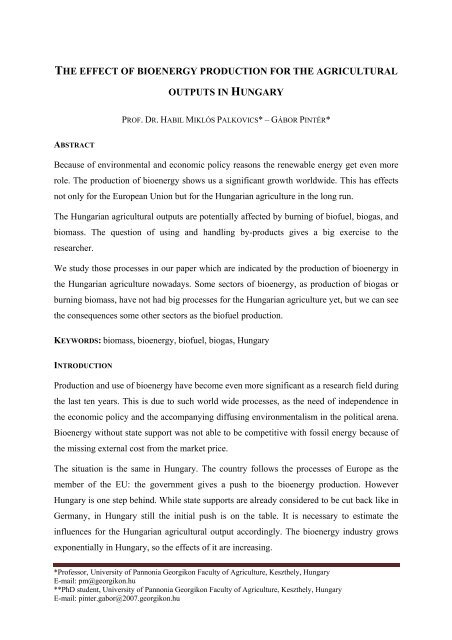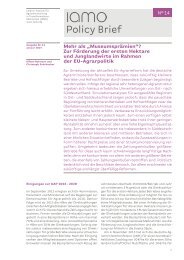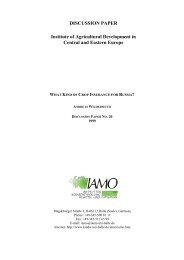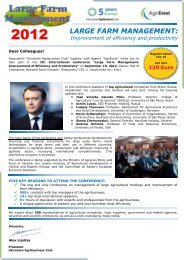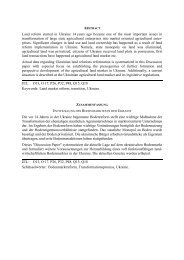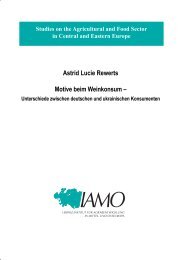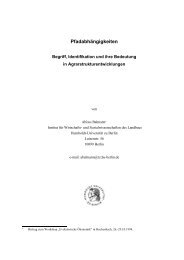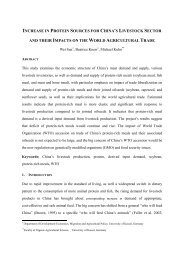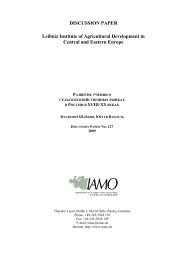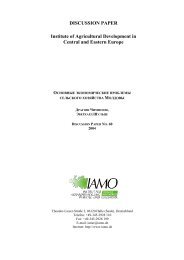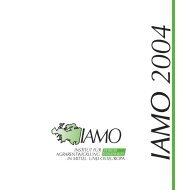the effect of bioenergy production for the agricultural outputs ... - IAMO
the effect of bioenergy production for the agricultural outputs ... - IAMO
the effect of bioenergy production for the agricultural outputs ... - IAMO
Create successful ePaper yourself
Turn your PDF publications into a flip-book with our unique Google optimized e-Paper software.
THE EFFECT OF BIOENERGY PRODUCTION FOR THE AGRICULTURAL<br />
ABSTRACT<br />
OUTPUTS IN HUNGARY<br />
PROF. DR. HABIL MIKLÓS PALKOVICS* – GÁBOR PINTÉR*<br />
Because <strong>of</strong> environmental and economic policy reasons <strong>the</strong> renewable energy get even more<br />
role. The <strong>production</strong> <strong>of</strong> <strong>bioenergy</strong> shows us a significant growth worldwide. This has <strong>effect</strong>s<br />
not only <strong>for</strong> <strong>the</strong> European Union but <strong>for</strong> <strong>the</strong> Hungarian agriculture in <strong>the</strong> long run.<br />
The Hungarian <strong>agricultural</strong> <strong>outputs</strong> are potentially affected by burning <strong>of</strong> bi<strong>of</strong>uel, biogas, and<br />
biomass. The question <strong>of</strong> using and handling by-products gives a big exercise to <strong>the</strong><br />
researcher.<br />
We study those processes in our paper which are indicated by <strong>the</strong> <strong>production</strong> <strong>of</strong> <strong>bioenergy</strong> in<br />
<strong>the</strong> Hungarian agriculture nowadays. Some sectors <strong>of</strong> <strong>bioenergy</strong>, as <strong>production</strong> <strong>of</strong> biogas or<br />
burning biomass, have not had big processes <strong>for</strong> <strong>the</strong> Hungarian agriculture yet, but we can see<br />
<strong>the</strong> consequences some o<strong>the</strong>r sectors as <strong>the</strong> bi<strong>of</strong>uel <strong>production</strong>.<br />
KEYWORDS: biomass, <strong>bioenergy</strong>, bi<strong>of</strong>uel, biogas, Hungary<br />
INTRODUCTION<br />
Production and use <strong>of</strong> <strong>bioenergy</strong> have become even more significant as a research field during<br />
<strong>the</strong> last ten years. This is due to such world wide processes, as <strong>the</strong> need <strong>of</strong> independence in<br />
<strong>the</strong> economic policy and <strong>the</strong> accompanying diffusing environmentalism in <strong>the</strong> political arena.<br />
Bioenergy without state support was not able to be competitive with fossil energy because <strong>of</strong><br />
<strong>the</strong> missing external cost from <strong>the</strong> market price.<br />
The situation is <strong>the</strong> same in Hungary. The country follows <strong>the</strong> processes <strong>of</strong> Europe as <strong>the</strong><br />
member <strong>of</strong> <strong>the</strong> EU: <strong>the</strong> government gives a push to <strong>the</strong> <strong>bioenergy</strong> <strong>production</strong>. However<br />
Hungary is one step behind. While state supports are already considered to be cut back like in<br />
Germany, in Hungary still <strong>the</strong> initial push is on <strong>the</strong> table. It is necessary to estimate <strong>the</strong><br />
influences <strong>for</strong> <strong>the</strong> Hungarian <strong>agricultural</strong> output accordingly. The <strong>bioenergy</strong> industry grows<br />
exponentially in Hungary, so <strong>the</strong> <strong>effect</strong>s <strong>of</strong> it are increasing.<br />
*Pr<strong>of</strong>essor, University <strong>of</strong> Pannonia Georgikon Faculty <strong>of</strong> Agriculture, Kesz<strong>the</strong>ly, Hungary<br />
E-mail: pm@georgikon.hu<br />
**PhD student, University <strong>of</strong> Pannonia Georgikon Faculty <strong>of</strong> Agriculture, Kesz<strong>the</strong>ly, Hungary<br />
E-mail: pinter.gabor@2007.georgikon.hu
2<br />
Contributed Paper presented at <strong>IAMO</strong> Forum 2008<br />
Hungary has excellent natural conditions <strong>of</strong> growing biomass. The annual sun hours are<br />
between 1700 - 2400 hours yearly. The amount <strong>of</strong> raining is between 800 - 450 mm. More<br />
than 50% <strong>of</strong> <strong>the</strong> territory <strong>of</strong> Hungary is tillage; <strong>the</strong> rate <strong>of</strong> <strong>the</strong> fields which are used by <strong>the</strong><br />
agriculture is more than 70%. The necessary plants <strong>for</strong> <strong>the</strong> <strong>bioenergy</strong> industry can give high<br />
produce because <strong>of</strong> <strong>the</strong> geographical situation.<br />
60<br />
50<br />
40<br />
30<br />
20<br />
10<br />
0<br />
Biomass potential in Hungary [PJ]<br />
58<br />
31<br />
36<br />
Potentially usable<br />
Currently<br />
harnessed<br />
Energy crops<br />
1. figure: Biomass potential in Hungary [source: Pr<strong>of</strong>. Kovacs K. MTA]<br />
Hungary has not used its opportunities in <strong>the</strong> sector <strong>of</strong> biomass as you can see on <strong>the</strong> 1 st<br />
figure. With <strong>the</strong> help <strong>of</strong> growing energy plants <strong>the</strong> potentially output energy could be <strong>the</strong><br />
double. Because <strong>of</strong> <strong>the</strong> getting stronger directives <strong>of</strong> <strong>the</strong> European Union (2003/30/EC<br />
bi<strong>of</strong>uels and 2001/77/EC “green power”) we have <strong>the</strong> consequence that <strong>the</strong> biomass<br />
<strong>production</strong> <strong>of</strong> Hungary will extremely grow in <strong>the</strong> next few years. The <strong>outputs</strong> <strong>of</strong> <strong>the</strong><br />
Hungarian agriculture will also change.<br />
1. PRODUCTION OF BIOETHANOL IN HUNGARY<br />
The national oil company <strong>of</strong> Hungary (MOL) have mixed 4.4 cubic % bioethanol to <strong>the</strong><br />
traditional petrol since 1 st July 2007. 88 thousand litres (70 thousand tons) bioethanol is<br />
mixed into 1.5 million tons (2 billion litres) petrol. [Popp] According to <strong>the</strong> 2003/96/EC<br />
energy taxation directive Hungary uses 103.5 Ft (1 € ≈ 260 Ft) tax refund pro <strong>the</strong> litre <strong>of</strong><br />
circulated bioethanol.<br />
Bioethanol is produced principally from maize and small amount (only <strong>for</strong> experiments) from<br />
sugar beet and from potato in Hungary. Accordingly <strong>the</strong> most affected <strong>agricultural</strong> output is<br />
<strong>the</strong> maize growing.<br />
The bioethanol <strong>production</strong> from sugar beet would be wanted in Hungary because only one<br />
sugar factory is working from <strong>the</strong> 12 ones that were working through centuries. Consequently<br />
Hungary has only <strong>the</strong> quarter <strong>of</strong> <strong>the</strong> <strong>for</strong>mer more than 100 thousand hectare sugar beet
The <strong>effect</strong> <strong>of</strong> <strong>bioenergy</strong> <strong>production</strong> <strong>for</strong> <strong>the</strong> <strong>agricultural</strong> <strong>outputs</strong> in Hungary<br />
<strong>production</strong> area. Each closed sugar factory means 100-200 workplaces. Bioethanol <strong>production</strong><br />
from sugar beet would be a great opportunity <strong>for</strong> <strong>the</strong> <strong>for</strong>mer farmers who grew sugar beet<br />
be<strong>for</strong>e.<br />
Since 2000 has begun <strong>the</strong> bioethanol <strong>production</strong> from maize in Hungary. A lot <strong>of</strong> investor<br />
announced to build bioethanol factory. You can see this process on <strong>the</strong> 2 nd figure. Numerous<br />
plans stopped in <strong>the</strong> process <strong>of</strong> authorisation and also numerous plans stopped just be<strong>for</strong>e <strong>the</strong><br />
physical investment. In 2007 Hungary had only two functioning bioethanol company. One <strong>of</strong><br />
<strong>the</strong>se two is <strong>the</strong> traditional Győr Distillery Company which increased its <strong>production</strong> and sells<br />
its product not only as alcohol but also as bioethanol too.<br />
2. figure: Bioethanol plans in Hungary [source: MBSZ]<br />
Only <strong>the</strong> Brazil bioethanol <strong>for</strong>m sugarcane was competitive with <strong>the</strong> traditional petrol without<br />
any support in 2007. The sugarcane gives <strong>the</strong> main field <strong>of</strong> <strong>the</strong> <strong>production</strong>. The bioethanol is<br />
produced principally from maize in Hungary, like <strong>the</strong> o<strong>the</strong>r countries which situated in <strong>the</strong><br />
temperate zone. You can see <strong>the</strong> parameters <strong>of</strong> <strong>the</strong> Hungarian maize growing in <strong>the</strong> last 15<br />
years on <strong>the</strong> 3 rd figure.<br />
3
4<br />
1300<br />
1200<br />
1100<br />
1000<br />
900<br />
Production area <strong>of</strong> maize<br />
[thousand ha]<br />
Maize<br />
Contributed Paper presented at <strong>IAMO</strong> Forum 2008<br />
1993<br />
1995<br />
1997<br />
1999<br />
2001<br />
2003<br />
2005<br />
2007<br />
10000<br />
8000<br />
6000<br />
4000<br />
2000<br />
Produced maize<br />
[thousand tons]<br />
Maize<br />
1993<br />
1995<br />
1997<br />
1999<br />
2001<br />
2003<br />
2005<br />
2007<br />
3. figure: Parameters <strong>of</strong> <strong>the</strong> Hungarian maize growing in <strong>the</strong> last 15 years [source: KSH]<br />
The <strong>production</strong> area <strong>of</strong> maize increased in <strong>the</strong> period <strong>of</strong> 1998 - 2007 because <strong>of</strong> <strong>the</strong> beginning<br />
<strong>of</strong> bioethanol <strong>production</strong>. The yearly amount <strong>of</strong> <strong>the</strong> produced maize was fluctuated because <strong>of</strong><br />
<strong>the</strong> wea<strong>the</strong>r. You can see <strong>the</strong>se processes on <strong>the</strong> 3 rd figure.<br />
Hungary has <strong>the</strong> goal to reach <strong>the</strong> 5.75% (in energy equivalent) mixing rate till 2010, that<br />
means 8.61 cubic % in point <strong>of</strong> <strong>the</strong> bioethanol. To achieve this goal 172 thousand litre (136<br />
thousand tons) bioethanol is needed to mix into <strong>the</strong> petrol. That amount <strong>of</strong> bioethanol can<br />
produce from 400 thousand tons <strong>of</strong> maize. If we assume 6 tons / hectare produced amount it<br />
will be necessary to sow 70 thousand hectares maize. [Popp] The <strong>production</strong> area <strong>of</strong> maize<br />
was fluctuating between 1100-1200 thousand hectares in <strong>the</strong> last 8 years, so Hungary’s<br />
bioethanol need will be only <strong>the</strong> 5-6% <strong>of</strong> <strong>the</strong> total maize <strong>production</strong> area in 2010. This is not a<br />
considerable need and has basically no influences <strong>for</strong> <strong>the</strong> Hungarian <strong>agricultural</strong> <strong>outputs</strong>. The<br />
annual need <strong>of</strong> 400 thousand tons <strong>of</strong> maize is only a small amount beside <strong>the</strong> Hungarian<br />
annual <strong>production</strong>, <strong>the</strong> 4000 – 8000 thousand tons. The wea<strong>the</strong>r is able to generate bigger<br />
<strong>effect</strong>s <strong>for</strong> <strong>the</strong> Hungarian maize growing than <strong>the</strong> bioethanol <strong>production</strong>.<br />
According to <strong>the</strong> opinion <strong>of</strong> <strong>the</strong> authors <strong>the</strong> amount <strong>of</strong> maize, which is used by bioethanol<br />
<strong>production</strong>, can not cause a big price-increasing; so <strong>the</strong> Hungarian feed-price will not increase<br />
heavily. The DDGS which is produced by secondary product <strong>of</strong> bioethanol <strong>production</strong> can be<br />
used as feed. If Hungary uses 400 thousand tons maize to produce bioethanol, minimum 100<br />
thousand tons <strong>of</strong> DDGS will be produced too. This amount <strong>of</strong> DDGS could replace <strong>the</strong> maize<br />
which is used by bioethanol <strong>production</strong>.<br />
Only <strong>the</strong> Hungarian bioethanol industry will not able to change basically <strong>the</strong> <strong>production</strong> area<br />
<strong>of</strong> maize and <strong>the</strong> <strong>agricultural</strong> <strong>outputs</strong> in Hungary in <strong>the</strong> next 5 years.
The <strong>effect</strong> <strong>of</strong> <strong>bioenergy</strong> <strong>production</strong> <strong>for</strong> <strong>the</strong> <strong>agricultural</strong> <strong>outputs</strong> in Hungary<br />
Hungary is dependent from <strong>the</strong> market <strong>of</strong> <strong>the</strong> European Union and from <strong>the</strong> market <strong>of</strong> <strong>the</strong><br />
world too. The international processes can heavily affect <strong>the</strong> Hungarian maize <strong>production</strong>.<br />
Because <strong>of</strong> <strong>the</strong> increased price <strong>of</strong> maize by <strong>the</strong> growing bioethanol <strong>production</strong> on <strong>the</strong> market<br />
<strong>of</strong> <strong>the</strong> world can raise export in Hungary. This process could cause a heavy increasing <strong>of</strong> <strong>the</strong><br />
<strong>production</strong> area <strong>of</strong> maize in Hungary in <strong>the</strong> long run.<br />
2. PRODUCTION OF BIODIESEL IN HUNGARY<br />
Hungary consumes annual about 2.5 million tons (3.5 billion litres) diesel oil. The national<br />
oil company (MOL) have mixed 4.4 cubic % biodiesel to <strong>the</strong> diesel oil since 1 st January 2008.<br />
It means 156 thousand litres (130 thousand tons) biodiesel. According to <strong>the</strong> 2003/96/EC<br />
energy taxation directive Hungary uses 85 Ft (1 € ≈ 260 Ft) tax refund pro <strong>the</strong> litre <strong>of</strong><br />
circulated biodiesel.<br />
4. figure: Planned biodiesel plants in Hungary [source: MTA]<br />
Biodiesel is produced principally from rape and smaller amount from sunflower in Hungary.<br />
The country can produce only 2 tons / hectare rape but <strong>for</strong> example Germany can produce<br />
around 4 tons / hectare. The climate in Hungary is excellent <strong>for</strong> <strong>the</strong> sunflower but oil can be<br />
produced more efficiently from rape than from sunflower.<br />
5
6<br />
Contributed Paper presented at <strong>IAMO</strong> Forum 2008<br />
You can see <strong>the</strong> planned and also <strong>the</strong> functioning biodiesel plants <strong>of</strong> Hungary on <strong>the</strong> 4 th<br />
figure. In 2007 Hungary had only 3 functioning biodiesel plants. Biodiesel <strong>production</strong> is not<br />
able to generate pr<strong>of</strong>it without any support in <strong>the</strong> world. Hungary has <strong>the</strong> same situation. Like<br />
numerous bioethanol plants many biodiesel plants “died” during <strong>the</strong> authorisation.<br />
You can see <strong>the</strong> parameters <strong>of</strong> Hungarian rape and sunflower <strong>production</strong> on <strong>the</strong> 5 th figure. The<br />
continuous growing <strong>of</strong> <strong>production</strong> area and produced amount <strong>of</strong> rape is readable from <strong>the</strong><br />
figure. The <strong>production</strong> area <strong>of</strong> <strong>the</strong> sunflower stagnates because Hungary uses all <strong>of</strong> its<br />
capacities to produce sunflower. The country gives more than 20% <strong>of</strong> <strong>the</strong> <strong>production</strong> <strong>of</strong> rape<br />
<strong>of</strong> <strong>the</strong> European Union. The Hungarian <strong>production</strong> area <strong>of</strong> sunflower can not grow any longer<br />
because <strong>the</strong> plant mustn’t be sowed in <strong>the</strong> same place during five years. Hungary has around<br />
4.6 million hectare tillage. In 2007 <strong>the</strong> <strong>production</strong> area <strong>of</strong> sunflower was 780 thousand<br />
hectare. Consequently more than <strong>the</strong> 1/6 total tillage was sowed with sunflower so <strong>the</strong> country<br />
reached its capacity-border.<br />
5. figure: Parameters <strong>of</strong> <strong>the</strong> Hungarian sunflower and rape growing [source: KSH]<br />
You can see unequivocally on <strong>the</strong> 5 th figure that thanks to <strong>the</strong> international growing <strong>of</strong> <strong>the</strong><br />
biodiesel <strong>production</strong> <strong>the</strong> Hungarian rape <strong>production</strong> is growing year by year. This process<br />
started in 2000 and has not stopped yet. The supply adapted to <strong>the</strong> delay. You can see this<br />
process only <strong>for</strong> rape because <strong>the</strong> capacity borders blocked <strong>the</strong> sunflower <strong>production</strong>. You can<br />
get oil from rape easier and cheaper than from sunflower at <strong>the</strong> present technical level.<br />
Hungary has <strong>the</strong> goal to achieve <strong>the</strong> 5.75% mixing rate (in energy equivalent) in 2010. This<br />
means 6.51cubic % mixed biodiesel which is equivalent 228 thousand litres, 200 thousand<br />
tons. The <strong>for</strong>ecasted demand <strong>of</strong> raw materials is 400 thousand rape or sunflower in 2010.<br />
[Popp] Biodiesel can be produced from dead oil so could decrease <strong>the</strong> <strong>effect</strong>s <strong>of</strong> <strong>the</strong> biodiesel<br />
<strong>production</strong> to <strong>the</strong> Hungarian <strong>agricultural</strong> <strong>outputs</strong>. The used rape or sunflower as raw material
The <strong>effect</strong> <strong>of</strong> <strong>bioenergy</strong> <strong>production</strong> <strong>for</strong> <strong>the</strong> <strong>agricultural</strong> <strong>outputs</strong> in Hungary<br />
could be change to <strong>the</strong> dead oil. Hungary does not have <strong>the</strong> assumptions to collect <strong>the</strong> dead oil<br />
and produce biodiesel from it.<br />
If we assume that Hungary is not able to collect a big amount <strong>of</strong> dead oil to create biodiesel in<br />
2010, it will be expedient to produce biodiesel only from rape. 400 thousand tons <strong>of</strong> rape<br />
means more than <strong>the</strong> fourth amount <strong>of</strong> <strong>the</strong> total (1500 thousand tons) rape <strong>production</strong> <strong>of</strong><br />
Hungary. Consequently it will be necessary to use more areas to produce rape in Hungary. If<br />
<strong>the</strong> amount <strong>of</strong> biodiesel which is made from sunflower increases, <strong>the</strong> price <strong>of</strong> <strong>the</strong> oil which is<br />
used by <strong>the</strong> households can be more expensive.<br />
The researcher should make allowance <strong>for</strong> <strong>the</strong> processes <strong>of</strong> <strong>the</strong> world market. The demand <strong>for</strong><br />
rape and sunflower can increase through <strong>the</strong> rise <strong>of</strong> biodiesel <strong>production</strong>. The European Union<br />
has a leader position in biodiesel <strong>production</strong> so <strong>the</strong>se processes have bigger <strong>effect</strong> in <strong>the</strong> EU.<br />
(Of course <strong>the</strong> demand <strong>of</strong> palm oil will increase but this process has <strong>the</strong> biggest <strong>effect</strong> only <strong>for</strong><br />
<strong>the</strong> agriculture <strong>of</strong> tropical countries.) The authors expect an increase <strong>of</strong> <strong>the</strong> price <strong>of</strong> <strong>the</strong> rapeand<br />
sunflower oil that generates a growing <strong>effect</strong> <strong>of</strong> rape <strong>production</strong> in Hungary. The country<br />
can expect a rising rape <strong>production</strong> area. Consequently <strong>the</strong> increasing rape <strong>production</strong> area<br />
may displace o<strong>the</strong>r plants but this process is very incalculable yet.<br />
Rape mill and sunflower mill are <strong>the</strong> by-products <strong>of</strong> biodiesel <strong>production</strong>. The sunflower mill<br />
is able to burn in power plants and <strong>the</strong> rape mill is an excellent feed. The authors expect a<br />
heavy decrease <strong>of</strong> <strong>the</strong> price <strong>of</strong> rape mill, because <strong>of</strong> increasing rape <strong>production</strong> <strong>of</strong> <strong>the</strong> last<br />
years. The rape mill can deputize <strong>the</strong> maize which is used <strong>for</strong> feed animals. Consequently <strong>the</strong><br />
price <strong>of</strong> feed can stagnate in <strong>the</strong> following years.<br />
In 2010 Hungary will grow 400 thousand tons <strong>of</strong> rape to produce biodiesel. As by-product <strong>the</strong><br />
country has 200 thousand tons rape mill in 2010. Confronting this numbers with that numbers<br />
which we have at <strong>the</strong> end <strong>of</strong> <strong>the</strong> last chapter we got <strong>the</strong> following result:<br />
Hungary will use 400 thousand tons <strong>of</strong> maize <strong>for</strong> its bioethanol <strong>production</strong> in 2010.<br />
Consequently 400 thousand tons <strong>of</strong> maize is missing as feed, but 100 thousand tons <strong>of</strong> DDGS<br />
is produced as by-product <strong>of</strong> bioethanol <strong>production</strong> + 200 thousand rape mill is produced as<br />
by-product <strong>of</strong> biodiesel <strong>production</strong>. We get <strong>the</strong> result that Hungary has 300 thousand tons <strong>of</strong><br />
feed instead <strong>of</strong> 400 thousand tons <strong>of</strong> maize as feed. It means that only 100 thousand tons <strong>of</strong><br />
feed will miss in 2010. These 100 thousand tons <strong>of</strong> feed can be compensated with a minimal<br />
growth <strong>of</strong> <strong>the</strong> <strong>production</strong> area <strong>of</strong> maize. Accordingly a high increasing <strong>of</strong> <strong>the</strong> feed prices<br />
because <strong>of</strong> <strong>the</strong> bi<strong>of</strong>uel <strong>production</strong> is not probable in Hungary.<br />
7
8<br />
3. BIOGAS PRODUCTION IN HUNGARY<br />
Contributed Paper presented at <strong>IAMO</strong> Forum 2008<br />
The rise <strong>of</strong> <strong>the</strong> Hungarian biogas <strong>production</strong> does not cause considerable <strong>effect</strong> in <strong>agricultural</strong><br />
<strong>outputs</strong>. Hungary uses mostly by-products to produce biogas. As you can see on <strong>the</strong> 6 th figure<br />
more than 60 % <strong>of</strong> <strong>the</strong> secondary-products are left on <strong>the</strong> fields. The by-products do not mean<br />
considerable nutrient <strong>for</strong> <strong>the</strong> plants which is grown on fields. Consequently biogas <strong>production</strong><br />
from by-products does not cause <strong>the</strong> growth <strong>of</strong> demand <strong>for</strong> chemical fertilizers. The<br />
secondary-products <strong>of</strong> biogas <strong>production</strong> can be used as an excellent fertilizer.<br />
63%<br />
6%5% 7%<br />
3%<br />
16%<br />
feed<br />
litter<br />
material <strong>for</strong><br />
burning<br />
roots, stuble<br />
stay on <strong>the</strong> fields<br />
6. figure: Tillage by-products in Hungary [source: KSH]<br />
Biogas can be produced from maize and from sugar beet. To use <strong>the</strong>se plants <strong>for</strong> biogas<br />
<strong>production</strong> is economically not so efficient than o<strong>the</strong>r kind <strong>of</strong> uses. But to produce biogas<br />
from by-products <strong>of</strong> <strong>the</strong>se plants can be economically efficient like in Kaposvár (Hungary),<br />
where biogas is produced from <strong>the</strong> secondary-products <strong>of</strong> <strong>the</strong> sugar factory. The advantages to<br />
produce biogas from by-products are <strong>the</strong> following processes: rising incomes <strong>of</strong> <strong>the</strong> farmers<br />
diversify markets and better quality <strong>of</strong> life. Accordingly Hungary tries to use even more byproduct<br />
to produce biogas. This process has no considerable <strong>effect</strong> <strong>for</strong> <strong>the</strong> <strong>agricultural</strong> <strong>outputs</strong><br />
in Hungary.<br />
4. ENERGY-FOREST – ENERGY-GRASS, EFFECTS FOR THE HUNGARIAN AGRICULTURE<br />
The energy <strong>for</strong>est does not give any income to <strong>the</strong> farmers at least in <strong>the</strong> first 2-3 years.<br />
Accordingly <strong>the</strong> Hungarian farmers which mostly have <strong>the</strong> problem <strong>of</strong> capital-scarce do not<br />
show a big interest <strong>of</strong> it. To grow o<strong>the</strong>r plants is more rewarding <strong>for</strong> <strong>the</strong> farmers on <strong>the</strong> pricelevel<br />
<strong>of</strong> nowadays.<br />
A special licence is needed <strong>for</strong> deployment an energy <strong>for</strong>est in Hungary. The Hungarians<br />
<strong>the</strong>rmal power stations usually buy <strong>the</strong> biomass from floristries. According to <strong>the</strong> 2001/77/EC<br />
“green power” directive <strong>of</strong> <strong>the</strong> European Union Hungary have to produce at least 6.2% energy<br />
else
The <strong>effect</strong> <strong>of</strong> <strong>bioenergy</strong> <strong>production</strong> <strong>for</strong> <strong>the</strong> <strong>agricultural</strong> <strong>outputs</strong> in Hungary<br />
<strong>of</strong> <strong>the</strong> total consumption from biomass. Hungary achieved <strong>the</strong> requirement already in 2007 so<br />
<strong>the</strong> governmental “push” is getting less on <strong>the</strong> matter <strong>of</strong> “green power“. Boilers which<br />
burning pellets have been found on <strong>the</strong> Hungarian market <strong>for</strong> 5 years. The authors expect that<br />
<strong>the</strong> demand <strong>for</strong> <strong>the</strong> pellet will grow in a long term because <strong>of</strong> <strong>the</strong> rising number <strong>of</strong> <strong>the</strong> boilers.<br />
The cost <strong>of</strong> <strong>the</strong> investment is really high so a peak-increase <strong>of</strong> <strong>the</strong> demand <strong>for</strong> pellets is not<br />
expected. Consequently <strong>the</strong> energy <strong>for</strong>est will not have a big <strong>effect</strong> <strong>for</strong> <strong>the</strong> <strong>agricultural</strong> <strong>outputs</strong><br />
in Hungary.<br />
The country has <strong>the</strong> same situation on <strong>the</strong> matter <strong>of</strong> energy grass. A big disadvantage <strong>of</strong><br />
burning energy grass is its needs <strong>for</strong> special boiler which is really expensive. The supply <strong>for</strong><br />
energy grass is low in Hungary because <strong>of</strong> <strong>the</strong> missing demand <strong>for</strong> it.<br />
Accordingly nei<strong>the</strong>r <strong>the</strong> energy <strong>for</strong>est nor <strong>the</strong> energy grass has considerable <strong>effect</strong>s <strong>for</strong> <strong>the</strong><br />
<strong>agricultural</strong> <strong>outputs</strong> in Hungary.<br />
CONCLUSION<br />
To study <strong>the</strong> growth <strong>of</strong> <strong>the</strong> Hungarian biomass <strong>production</strong> <strong>the</strong> authors expect considerable<br />
<strong>effect</strong> only from <strong>the</strong> rape <strong>production</strong> to <strong>the</strong> <strong>agricultural</strong> <strong>outputs</strong>. Nei<strong>the</strong>r <strong>the</strong> biogas nor <strong>the</strong><br />
energy <strong>for</strong>est or <strong>the</strong> energy grass can cause big <strong>effect</strong> <strong>for</strong> <strong>the</strong> <strong>agricultural</strong> <strong>outputs</strong> in Hungary<br />
in <strong>the</strong> next few years. The demand <strong>for</strong> maize as basic material <strong>for</strong> bioethanol <strong>production</strong> will<br />
increase but <strong>the</strong> demand <strong>for</strong> maize as feed will decrease because <strong>of</strong> <strong>the</strong> growth <strong>of</strong> <strong>the</strong><br />
secondary-products <strong>of</strong> bi<strong>of</strong>uel <strong>production</strong>. Consequently <strong>the</strong> authors expect only a minimal<br />
growth <strong>of</strong> <strong>the</strong> <strong>production</strong> area <strong>of</strong> maize in <strong>the</strong> next few years.<br />
The biodiesel <strong>production</strong> <strong>of</strong> Hungary has bigger <strong>effect</strong> <strong>for</strong> <strong>the</strong> <strong>agricultural</strong> <strong>outputs</strong>. The<br />
<strong>production</strong> area <strong>of</strong> rape has grown more than 30% since 2001. The authors expect more than<br />
25% accession <strong>of</strong> <strong>the</strong> Hungarian rape <strong>production</strong> area till 2010 because <strong>of</strong> <strong>the</strong> continuously<br />
growth <strong>of</strong> it.<br />
The processes <strong>of</strong> <strong>the</strong> word market and <strong>the</strong> Hungarian export / import rate can have big<br />
influences to <strong>the</strong> values which are counted by <strong>the</strong> authors.<br />
If <strong>the</strong> processes <strong>of</strong> <strong>the</strong> word market do not change much and <strong>the</strong> energy policy <strong>of</strong> <strong>the</strong><br />
European Union remains <strong>the</strong> same, <strong>the</strong> <strong>production</strong> area <strong>of</strong> <strong>the</strong> rape will raise a lot in Hungary.<br />
9
10<br />
REFERENCES<br />
Contributed Paper presented at <strong>IAMO</strong> Forum 2008<br />
• Ángyán József Balázs Katalin, Nagy Gábor; Fenntartható, többfunkciós mezőgazdaság;<br />
Bp. : Elgoscar-2000, 2006<br />
• Balkányi Gábor; A megújuló energia jövője Magyarországon; Budapest. : BKÁE, 2004<br />
• Bai Attila; A biogáz; Budapest: 2007; ISBN: 978-963-7024-30-6<br />
• Csete László, Láng István; A fenntartható agrárgazdaság és vidékfejlesztés; Budapest:<br />
MTA Társadalomkut. Közp., 2005<br />
• Gonczlik Andrea, Kazai Zsolt, Kőrös Gábor; Új utak a mezőgazdaságban; Budapest:<br />
Energia Klub, 2005<br />
• Klass, Donald L; Biomass <strong>for</strong> Renewable Energy, Fuels, and Chemicals; London; ISBN-<br />
10: 0-12-410950-0<br />
• Juhász Lajos; A közgazdasági feltételek és az agrárgazdaságok beruházási lehetőségei;<br />
Budapest: Akad. K., 2003<br />
• Popp József; A bioüzemanyag-gyártás nemzetközi összefüggései; Budapest: AKI 2007<br />
• Sántha Attila; A természeti tőke és az agrárgazdaság szerepe a területi versenyképességben;<br />
Pécs : Pécsi Tudományegyetem Közgazdaságtudományi Kar, 2004<br />
• Twidell, John W; Renewable energy resources; London: 2006; ISBN: 0-419-25330-0<br />
• Vass Zoltán; A megújuló energia<strong>for</strong>rások hasznosítása; Energia Központ Kht., Budapest


